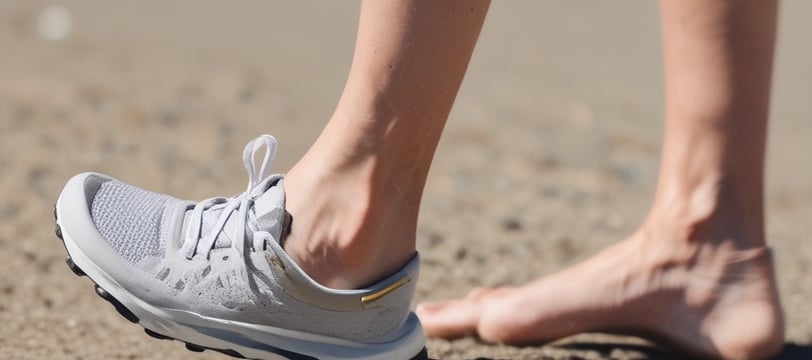The Best Types of Running Shoes for Every Foot Type
5/28/20254 min ler


Understanding Foot Types
Understanding one's foot type is essential for selecting appropriate running shoes that enhance comfort and performance. The three primary foot types are flat feet, high arches, and neutral arches, each characterized by distinct anatomical features that significantly influence running mechanics.
Flat feet, or overpronated feet, have little to no arch, causing the foot to roll inward excessively during gait. This condition can lead to various issues, including plantar fasciitis, shin splints, and knee pain, as the body compensates for the lack of arch support. Runners with flat feet benefit from stability or motion control shoes, which provide additional arch support and structure, helping to maintain proper alignment and reduce the risk of injuries.
On the opposite end of the spectrum are individuals with high arches, characterized by a pronounced arch that does not flatten when bearing weight. This foot type often results in underpronation, where the foot does not roll inward enough during impact. Runners with high arches tend to experience issues such as Achilles tendonitis and metatarsalgia due to excessive pressure on the heel and forefoot. For this foot type, cushioned shoes are recommended, as they offer more padding and support to absorb shock and distribute pressure evenly across the foot.
Neutral arches represent the ideal foot type, where the arch is neither excessively high nor flat. This balance allows for efficient shock absorption and stability during running. Runners with a neutral arch typically fare well with a variety of shoe styles, ranging from neutral cushioning shoes to light stability options. Understanding these distinctions in foot types is crucial for making informed decisions when selecting running shoes, ultimately leading to improved performance and reduced injury risk.
Running Shoes for Flat Feet
For individuals with flat feet, selecting the right running shoes is crucial to ensure comfort, stability, and proper foot alignment during exercise. Flat feet, characterized by a low or nonexistent arch, can lead to overpronation, a condition where the foot rolls inwards excessively. This biomechanical issue can result in various injuries and discomfort if not addressed through appropriate footwear. Therefore, flat-footed runners should prioritize stability and motion control shoes that provide ample arch support and cushioning.
When searching for the best running shoes for flat feet, it is essential to look for features such as firm midsoles, which help to support the foot's structure and prevent excessive rolling. Several shoe models are highly recommended for those with flat feet. The Brooks Adrenaline GTS series, for instance, is well-regarded for its stability features and comfortable fit. Another excellent option is the ASICS Gel-Kayano, which offers a good balance of support and cushioning, making it suitable for long-distance running. Additionally, the New Balance 860 V11 stands out for its effective motion control and reliable support system.
In terms of cushioning, flat-footed runners should seek shoes that offer adequate shock absorption to lessen the impact on their feet and joints. Lightweight models with flexible designs can also help in maintaining comfort during runs. Moreover, considering the shoe's overall fit is vital; opting for a wider toe box can alleviate pressure on the feet, allowing for better circulation and reduced friction. With the right running shoes, individuals with flat feet can enjoy their running routine while minimizing the risk of injury and enhancing their overall performance.
Running Shoes for High Arches
Individuals with high arches often experience a unique set of challenges when it comes to running. The elevated structure of the foot leads to uneven weight distribution, which can result in increased pressure on the forefoot and heel. Consequently, selecting the appropriate running shoes becomes crucial for both performance and injury prevention. High-arched runners generally require shoes that provide ample cushioning and shock absorption to accommodate their foot structure effectively.
Key features to look for in running shoes for high arches include responsive cushioning systems and adequate support in the midsole area. Shoes equipped with technologies such as EVA (ethylene-vinyl acetate) or polyurethane midsoles are known to offer superior shock absorption, minimizing the impact on the feet and joints during running. Additionally, a flexible outsole can help promote a more natural foot movement while providing the required grip and traction on various surfaces.
Some specific technologies beneficial for high-arched runners include arch-supporting insoles and heel cushioning pads that can enhance comfort. Stability features, such as medial posts, can also facilitate proper alignment and reduce the likelihood of overpronation, which is a common concern for this foot type. It is crucial to choose shoes that strike a balance between comfort, support, and flexibility to accommodate the high arch without compromising running performance.
Several recommended models for high-arched runners include the Brooks Ghost series, known for its plush cushioning; the ASICS Gel-Kayano, which offers excellent stability; and the Saucony Triumph, designed to provide superior comfort. Each of these options incorporates elements specifically aimed at enhancing the running experience for individuals with high arches. By carefully selecting shoes tailored for this foot type, runners can significantly improve their performance and reduce the risk of injuries associated with improper footwear.
Running Shoes for Neutral Arches
Neutral arches are considered the most versatile foot type when it comes to running. This foot structure provides a balanced distribution of weight and allows for a natural gait cycle. Runners with neutral arches typically experience less strain on their feet and legs during high-impact activities, making them less prone to injury. As a result, individuals with neutral arches have the flexibility to choose from a wide selection of running shoes, which can significantly enhance their overall running experience.
When selecting running shoes for neutral arches, it is crucial to focus on a well-balanced combination of cushioning and support. Shoe designs for this foot type generally feature moderate cushioning to absorb impact while maintaining a stable feel. This balance is essential as it ensures proper responsiveness during running sessions, allowing for efficient energy transfer. Additionally, neutral shoes often have a flexible outsole to facilitate natural foot movement, contributing to a more comfortable run.
To choose the right running shoes for a neutral arch, consider factors such as the intended use, terrain, and personal preference for cushioning. For instance, if you primarily run on roads, look for shoes with ample cushioning and a smooth ride, while trail runners might prefer models with more grip and durability to handle uneven surfaces. Furthermore, always ensure a proper fit, as an ill-fitted shoe can lead to discomfort and potential injuries.
Some top picks for runners with neutral arches include the ASICS Gel-Nimbus series, Brooks Ghost models, and the Nike Pegasus line. Each of these options provides an excellent balance of support and cushioning, making them suitable for various distances and running styles. By carefully evaluating these characteristics and selecting the right pair, neutral runners can enhance their performance while enjoying their time on the road or trail.
Mindfulness
Explore motivation and movement for mental clarity.
Resilience
Running
contact@runtrise.com
© 2025. All rights reserved.
